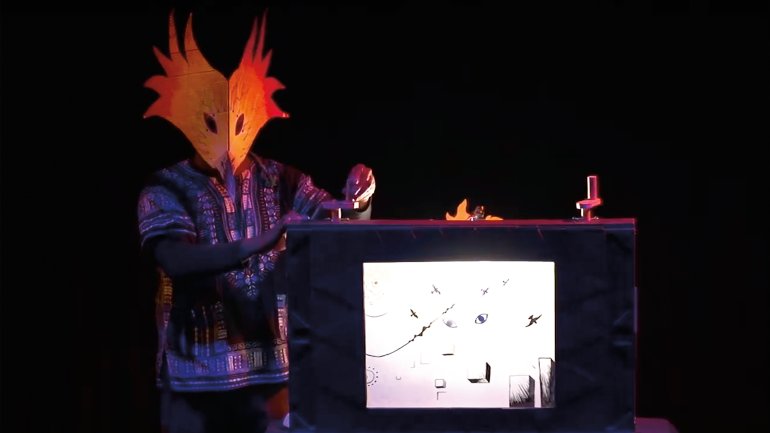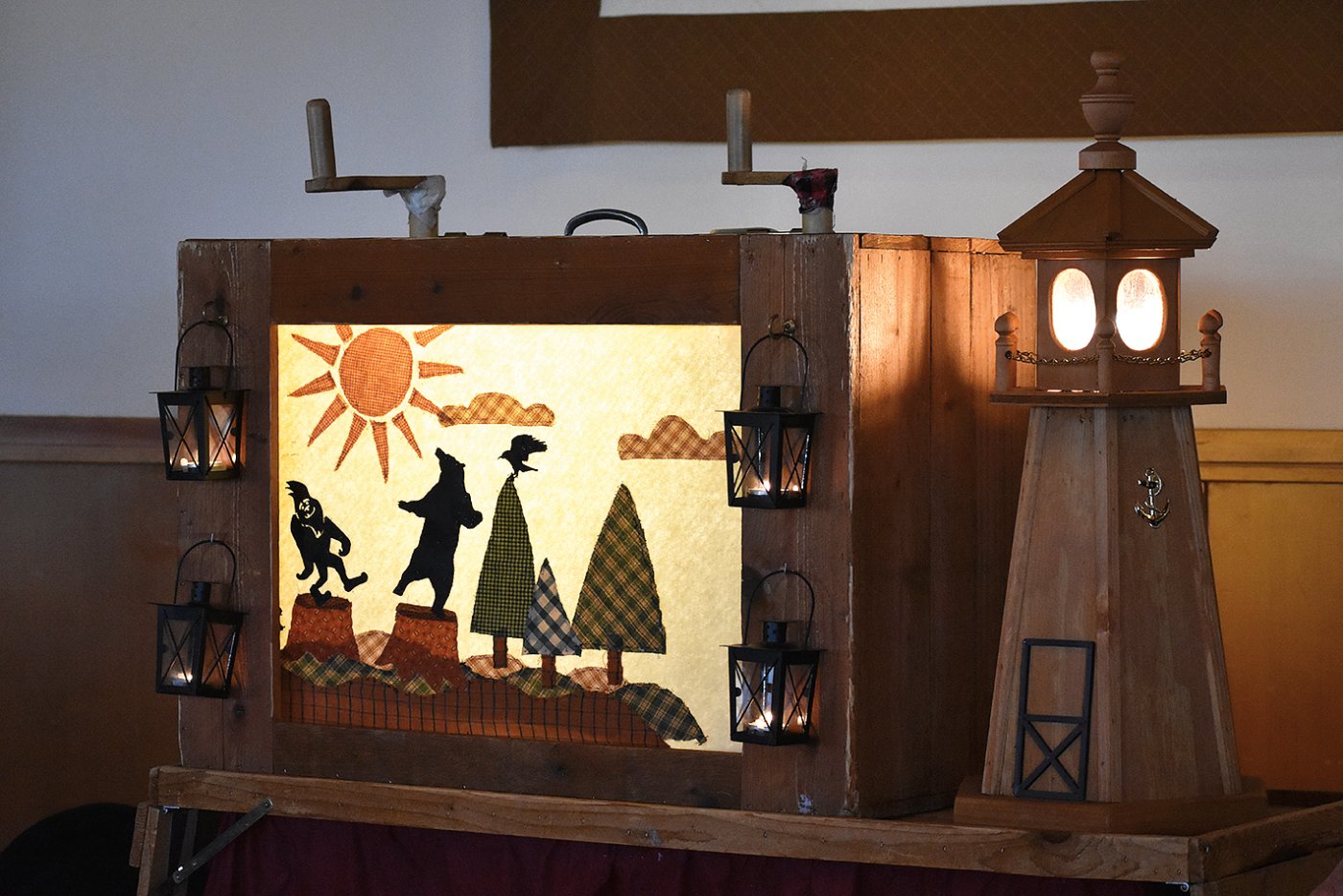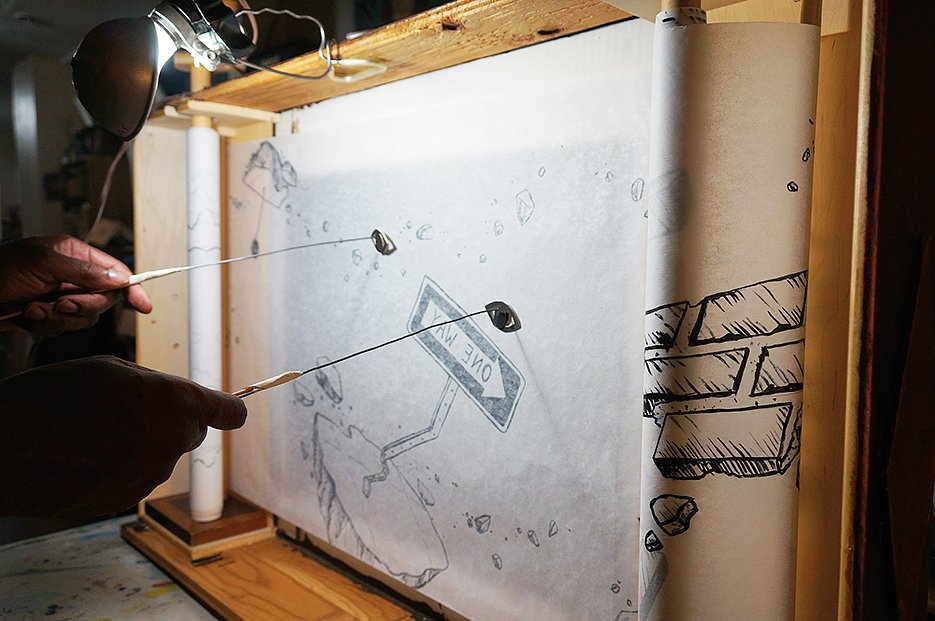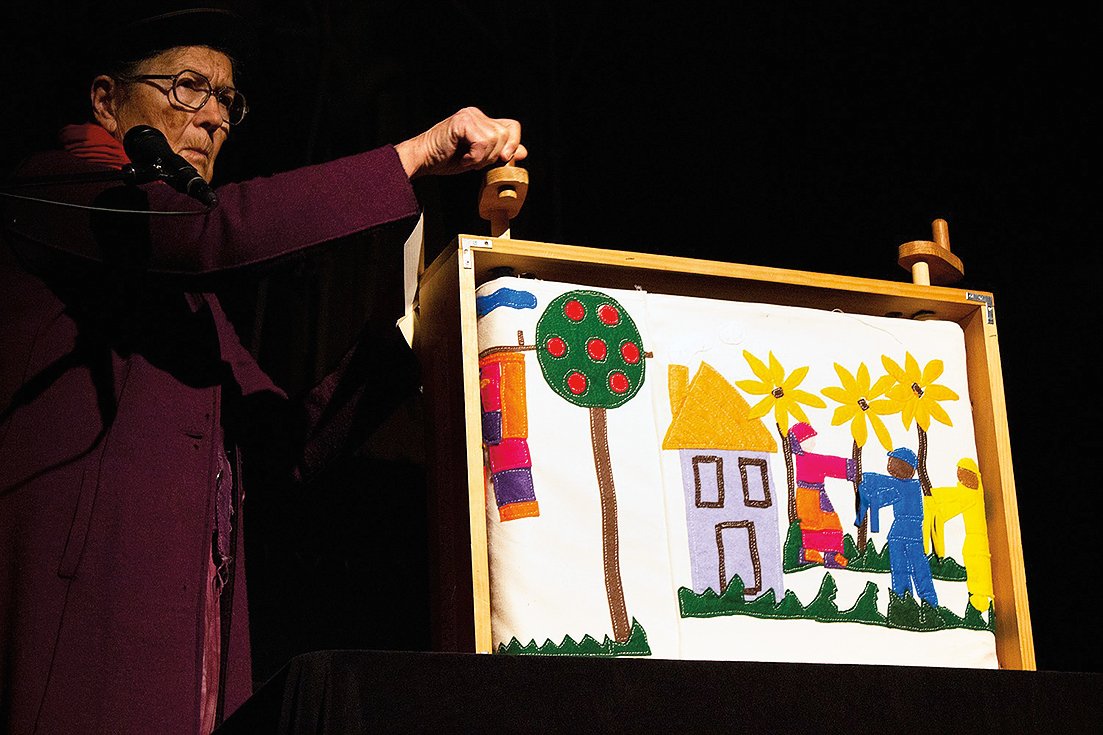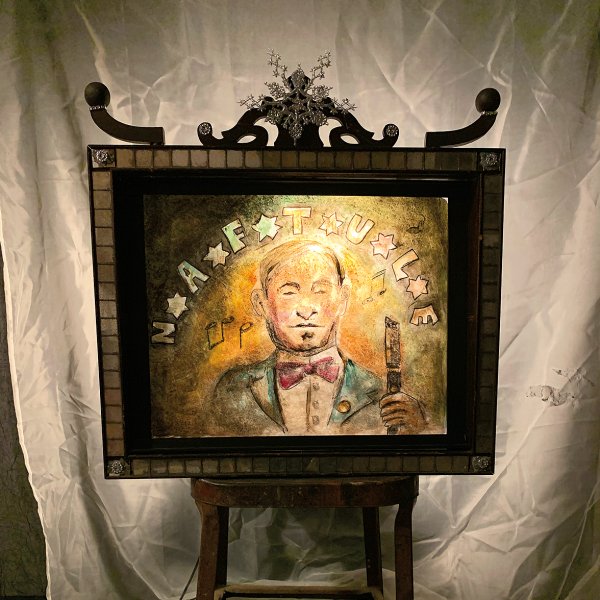Hand-Turned Tales
Hand-Turned Tales
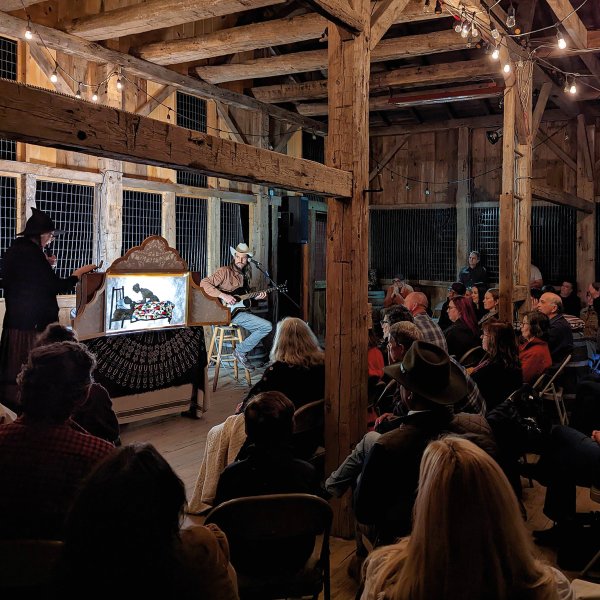
Katherine Fahey (left), Caleb Stine (right, on guitar), and Dan Van Allen (hidden behind the crankie) perform a ghost story called “I Know Moonrise” at Manor Mill art space in Monkton, Maryland. Photo by Bo Willse.
Nearly every February, artists from Pittsburgh, Baltimore, and beyond gather for a weekend of art, music, and storytelling in the sparsely populated hill town of Confluence, Pennsylvania. Hosted by the Best family, this event, called the Festival of Scrolling Panoramic Art, takes place in a small, red brick building that once housed a church. Having established the nonprofit Confluence Creative Arts Center, educators Jay and Jody Best like to say, “We are small, but we are mighty.” At the Confluence celebration—just one of several North American festivals each year that celebrate handmade story-telling scrolls known as “crankies”—makers gather from around the region to share their latest creations.
The so-called crankie revival has been gaining momentum ever since German émigré Peter Schumann founded the Bread and Puppet Theater on the Lower East Side of Manhattan in 1963. Hardly the first individual to create hand-cranked moving pictures, Schumann is credited with coming up with the term cranky (or crankie). And although he would soon become known for his larger-than-life puppets, Schumann’s early tabletop productions planted a creative seed.
Visitors to Sue Truman’s highly informative website, The Crankie Factory, will come across her succinct description of this art form: “Start with a long illustrated scroll that is wound onto two spools. The spools are loaded into a box which has a viewing window. The scroll is then hand-cranked while the story is told, a song is sung or a tune is played.” Truman’s website provides examples of the many materials from which scrolls can be made and the various methods used for their illustration. It also instructs visitors on how to build an 18-by-36-inch wooden crankie frame.
Truman started TheCrankieFactory.com more than a decade ago in response to the dearth of information on this craft: its history appeared to begin with Schumann in the beatnik days of the 1960s, but it is actually centuries old. Her goal was to make crankie historians and artisans aware of one another. Nowadays, she is gratified to see that grade school teachers use her pages, as do university professors, who often cite her website on folklore class syllabi.
Alternately referred to as “moving panoramas,” “scrolls,” or “moving pictures,” these early entertainments were popular in Europe, as well as in Asia and North America. Civil War crankies—of which a fragile handful survive—were a largely journalistic art form used to broadcast news of the latest battles. As summarized by Truman, “In the 19th century, moving panoramas ranged in size from very small to enormous!” Some were fashioned out of canvas, others out of muslin. A rope was attached across the top to keep the scroll from drooping—a perpetual technical challenge. The largest crankies were feats of engineering, as described in curator and professor Erkki Huhtamo’s book Illusions in Motion: Media Archaeology of the Moving Panorama and Related Spectacles. Writer Mark Twain also made reference to them in his story “The Entertaining History of the Scriptural Panoramist.”
Launched in 2010, the Crankie Factory website has been a catalyst for what Truman characterizes as the second crankie revival. Early on, she showcased the work of multidisciplinary artists Anna Roberts-Gevalt and Elizabeth LaPrelle. Consisting of 18-inch-high illustrated easel paper or muslin, these crankies feature folktales or ballads, and their performance is enlivened by the accompaniment of Appalachian tunes played on banjo or fiddle. This combination of visual and auditory artistry typically holds audiences spellbound: “I cried the first time I saw Anna and Elizabeth perform,” Truman says. Indeed, crankies are particularly popular in traditional folk music circles, where they are appreciated for their otherworldly and expressive qualities. Some individuals, such as Sam Bartlett in Indiana and Brendan Taaffe in Vermont, have found that crankie making allows them to bring together what would otherwise be dueling career paths—their lives as visual artists and as musicians.
A New Development
Back in 2010, Baltimore artist Katherine Fahey had already made a song-based crankie or two for musician friends when her singer-songwriter friend Caleb Stine insisted she attend a concert at his house. She arrived in time to see “The Lost Gander,” a production by Roberts-Gevalt and LaPrelle. She was struck by the beauty of their work and the hazards it presented: a paper crankie, complete with papercut figures and a stick-puppet goose suspended over the scrolled landscape, all of which was illuminated by candlelight. Fahey, who envied the immediacy of connection between musicians and their listeners, describes herself as shy. But she suddenly realized she didn’t have to make crankies for other people; she could make them for herself. Nor would she have to worry about selling her art; she “could share it over and over again” through her own performances.
Trained as a sculptor at the Maryland Institute College of Art (MICA), Fahey downplays the role her formal schooling has had in her success as a crankie artist. Her father, a cartographer who made maps by hand and who mentored decades’ worth of students at Catholic University in Washington, DC, was likely a greater influence. “I was in the post office one day and they had those Tyvek envelopes,” Fahey recalls. While standing in line, she examined the material at hand and found that it was both indestructible and had a graininess on one side that would absorb pigment. Better yet, it could be purchased in rolls.
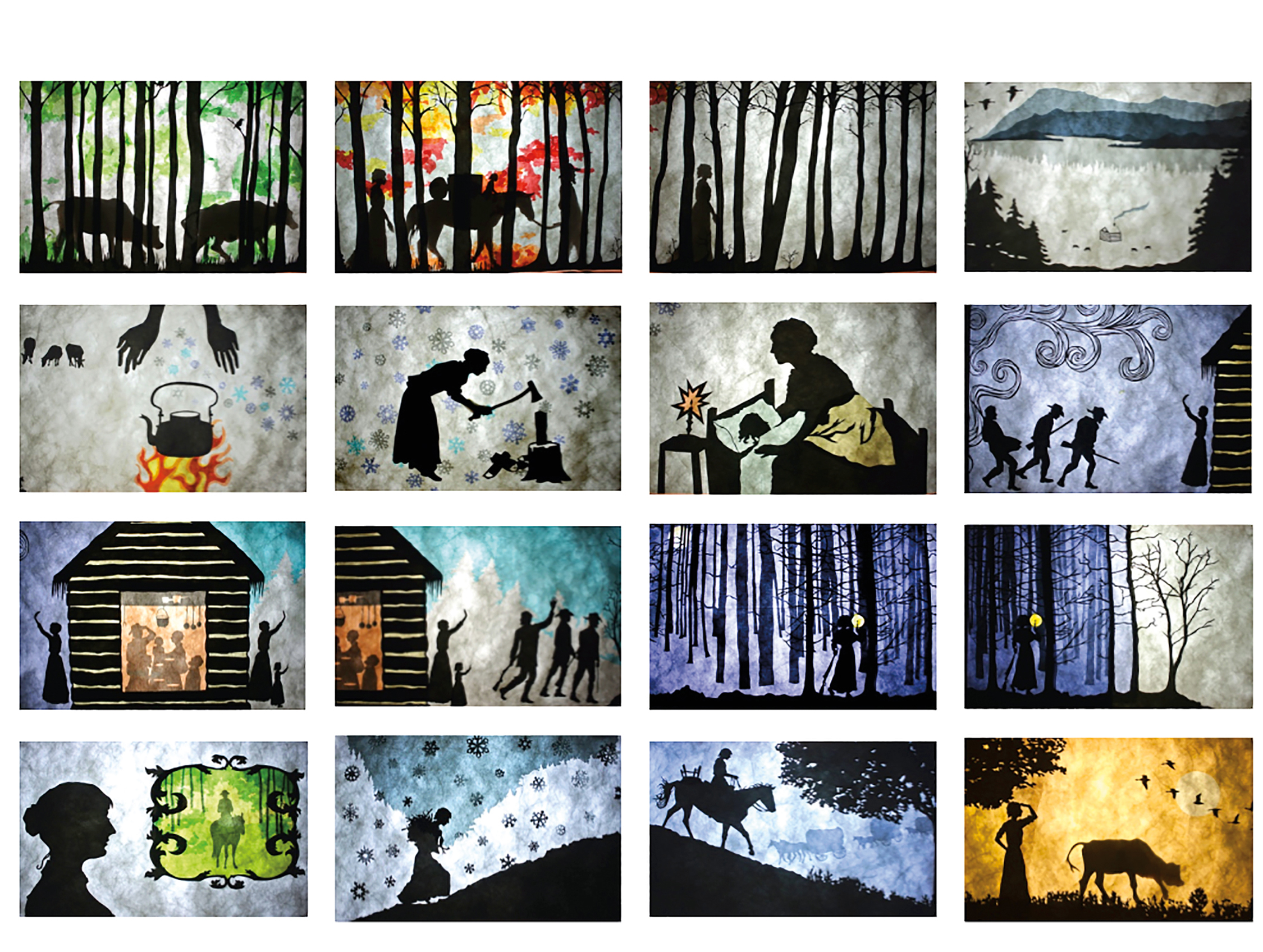
So began her use of Tyvek for scrolls. Thanks to her father, Fahey grew up with an X-Acto blade in her hand. Rather than using Sharpies or paint for the illustrations, she cuts black Tyvek to create silhouettes of scenes and characters, then glues them to the white Tyvek background. She also makes use of patterned tissue paper and origami to add color to her work. Early on, Fahey joined creative forces with her new “crankie sisters,” Roberts-Gevalt and LaPrelle. “We went on a tour of the Northeast. . . . It was magical and unexpected. People were putting us up and supporting us.”
Other crankie enthusiasts choose to work with textiles. Ursula Populoh, an 81-year-old German émigré, uses canvas for her scrolls and decorates them with hand-embroidered lettering and applique. “I was seventy-one when I started at art school—a very old student,” she proudly declares. Her fiber artist daughter Valeska, who is on the faculty at MICA, built her mother’s frame. Unlike Fahey and the many individuals who backlight crankies using candles or electric bulbs, Populoh does not illuminate her crankies. Says Populoh, who created a quilt that tells her embroidered emigration story, “My mantra is do everything by hand.”
Growing Popularity
Arts producer Josh Kohn of the Center for Cultural Vibrancy has curated almost a decade’s worth of Baltimore Crankie Festivals. While he admits that “it often includes a little more hand-holding,” Kohn regularly invites participants who are “outside the tradition and new to that art form,” such as folk artists from Ethiopia. Kohn wrote the script for the one-of-a-kind “Naftule Brandwein” crankie that is based on the life of the klezmer clarinet virtuoso. Six months in the making, this crankie became an elaborate collaboration between musicians, illustrators, and audio artists, and featured a live performance by clarinetist Michael Winograd, who was—like Brandwein—bedecked in lights. Kohn sees unique connections between Jewish culture and crankies: “It’s a form of the Torah scroll and the Megillah. Move forward [in the narrative] without turning a page. Every Jewish holiday is about telling another story.”
Nowadays, folk musicians and artisans from nearly every community seem to be embracing crankies, including organizations such as KlezKanada, the Massachusetts-based Country Dance & Song Society, WUMB Radio Acoustic Music Weeks in New Hampshire, and North Carolina’s John C. Campbell Folk School, among others. Crankie luminaries aside, the greatest appeal of this craft seems to lie in its inclusive, approachable character—everyone has a story to tell, and you don’t have to be an established artist to share it.
breadandpuppet.org | @breadandpuppet
thecrankiefactory.com | @suetruman1015
@elizabethlaprelle
sambartlett.com | @realsambartlett
brendantaaffe.com | @turtledovesings
@katherine_fahey
ursulapopuloh.net | @ursulapopuloh
@dirkjart
stringtheorytheater.weebly.com | @stringtheorytheater
blackcherrypuppettheater.weebly.com
@blackcherrypuppettheater


